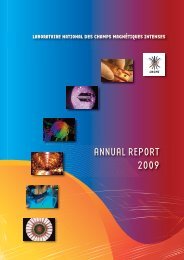Laboratoire National des Champs Magnétiques Pulsés CNRS – INSA
Laboratoire National des Champs Magnétiques Pulsés CNRS – INSA
Laboratoire National des Champs Magnétiques Pulsés CNRS – INSA
You also want an ePaper? Increase the reach of your titles
YUMPU automatically turns print PDFs into web optimized ePapers that Google loves.
X-ray absorption spectroscopy (XAS) and magnetic circular dichroism (XMCD) in pulsed magnetic field<br />
By coupling the mobile pulsed magnetic field device developed at the LNCMI-T to the fast acquisition<br />
possibilities of the ESRF energy-dispersive XAS beamline ID24, the feasibility of measuring X-ray magnetic<br />
circular dichroïsm (XMCD) in pulsed magnetic fields up to 30 T using long pulses has been investigated.<br />
Our first high field XAS and XMCD experiments on Gd foil (December 2006) and URhGe single crystal<br />
(February 2007) showed that the feasibility and the quality of the measurement strongly depend on the<br />
mechanical stability of the experimental setup. This high sensitivity to mechanical stability derives from the<br />
specific features of the beamline ID24, more particularly the use of a polychromatic dispersive light that is<br />
focused into a very small spot of 5 microns horizontally. In these geometrical constraints, the acquisition of<br />
absorption spectra under in-situ pulsed magnetic field is challenging because of potential vibrations and motions<br />
induced by the production of the high field pulse, therefore requires excellent sample homogeneity and position<br />
stability within the beam focal spot.<br />
To reduce the observed vibrations effects in the setup, modifications of the cryostat <strong>des</strong>ign and mechanical<br />
improvements are under study. The vibrations effects have been already drastically reduced form the initial<br />
configuration (where it was exceeding 1mm) by consolidating cryostat internal tube with the chamber holding<br />
the coil. With this new configuration, XMCD measurements have been successfully performed on a<br />
Gd5Si1.8Ge2.2 powder sample. Data analysis are still under progress.<br />
High magnetic field neutron diffraction<br />
The magnetic properties of geometrically frustrated systems are among the hot topics in condensed matter<br />
physics. In such systems, a variety of unconventional phases appears due to a frustrated spin interaction that<br />
couples with lattice, orbital and charge degrees of freedom. We can tune the balance between them using strong<br />
magnetic field through the Zeeman interaction of spins, and various novel magnetic phases have been found in<br />
magnetic fields exceeding 20 T. Neutron scattering is a powerful and valuable technique to directly determine<br />
the space- and time-correlation of magnetic moments, and to have a deeper insight into the origin of the novel<br />
phases in high fields. So far, however, sufficiently high magnetic fields have not been accessible for neutron<br />
scattering studies. In view of the successful X-ray scattering experiments at the ESRF using a mobile pulsed<br />
field installation, capable of generating fields in excess of 30 T, we have decided to attempt a neutron scattering<br />
experiment using this installation, at the Institut Laue Langevin (ILL, Grenoble) in collaboration with Prof.<br />
Nojiri’s group from Sendai (IMR, Tohoku University, Japan).<br />
Neutron diffraction study of the frustrated antiferromagnet TbB 4[6]<br />
This new technique was used to investigate the magnetic structure of the geometrically frustrated system TbB4,<br />
in magnetic fields up to 30 T. The experiment was carried out on the high-flux, low background triple-axis<br />
spectrometer IN22, with a neutron wavelength of 1.53 Å, using a transportable pulsed magnet system built up by<br />
Prof. Nojiri’s group and the mobile capacitor bank developed at the LNCMI-T<br />
At room temperature, TbB4 crystallizes in the tetragonal structure P4/mbm. The network of magnetic Tb ions<br />
consists of squares and triangles whose configuration within the c-plane is characterized by orthogonal dimers<br />
topologically equivalent to the two dimensional Shastry-Sutherland lattice (SSL) [1]. In zero field, TbB4 exhibits<br />
two successive antiferromagnetic transitions at TN1 = 44 K and TN2 = 24 K [2]. The magnetic structure at B = 0 T<br />
is a XY-type noncollinear structure [3]. At low temperature and high fields (between 16 and 30 T), multi-step<br />
magnetization plateaus appear when the magnetic field is perpendicular to the magnetic easy plane (fig. 4) [4].<br />
This behaviour is unusual since successive metamagnetic transitions in rare earth intermetallics are generally<br />
expected when the field is parallel to the Ising easy axis [5]. Therefore the determination of magnetic structure of<br />
TbB 4 in high magnetic field is essential to understand this phenomenon.<br />
Within the constraints of the pulsed magnet system developed for neutron scattering, we have succeeded in<br />
measuring the field dependences of four Bragg reflections ((100), (200), (110) and (220)) up to 30 T. The<br />
neutron counts and magnetic fields were measured simultaneously using a time analysing system so that the field<br />
dependence of Bragg peaks at fixed diffraction angle can be monitored and recorded as a function of time. The<br />
accumulation of 100-200 magnetic field pulses for each reflection was required to acquire statistically relevant<br />
data. As an example, the field dependence of the intensity of the (100) peak is reported on figure 5. The relative<br />
intensity against the zero field intensity I/I 0 and the relative magnetization M/M S are reported in the figure.<br />
Stepwise changes which can be related to the magnetization process are clearly observed in the intensity of the<br />
magnetic (100) reflection.<br />
From these experimental results, different magnetic models have been calculated. They indicate a much weaker<br />
AF correlation in TbB 4 than the expected one in a conventional antiferromagnet and also suggest the presence of<br />
significant anisotropic interactions. A model introducing a biquadratic interaction term which stabilizes an<br />
36







